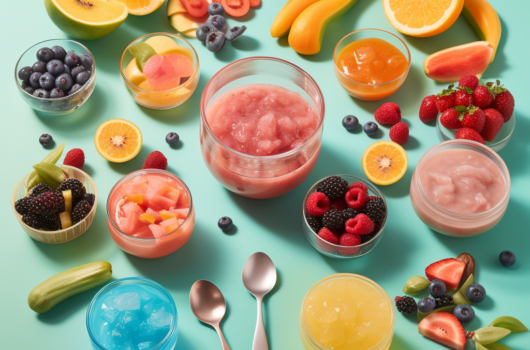When it comes to introducing solid foods into a baby’s diet, parents often find themselves navigating through a sea of conflicting information. One food that has gained popularity in recent years is jello. However, concerns about its safety and suitability for babies have also emerged. In this article, we will delve into the various aspects surrounding jello consumption for infants, including nutritional analysis, potential choking hazards, allergenicity and sensitivities, homemade vs store-bought options, as well as expert recommendations and guidelines.
- Nutritional Analysis: Examining the Suitability of Jello as a Baby Food Option
- Potential Choking Hazards: Assessing the Risks Associated with Feeding Jello to Infants
- Allergenicity and Sensitivities: Investigating Possible Reactions to Jello in Babies
- Homemade vs Store-Bought Options: Comparing Safety Measures and Ingredients in Different Varieties of Jello for Babies
- Expert Recommendations and Guidelines: Exploring Professional Advice on Introducing Jello into a Baby’s Diet
Nutritional Analysis: Examining the Suitability of Jello as a Baby Food Option
Jello is primarily made from gelatin – a protein derived from collagen found in animal bones or skin. While it may seem like an innocent treat due to its colorful appearance and sweet taste, jello lacks essential nutrients required for optimal growth and development in babies. According to pediatric nutritionists at Johns Hopkins Medicine (2021), jello contains minimal amounts of vitamins and minerals compared to other fruits or vegetables commonly recommended during early stages of feeding.
Furthermore, most commercial varieties of jello are loaded with added sugars which can contribute to tooth decay and obesity if consumed excessively by infants. The high sugar content not only poses risks but also fails to provide any substantial nutritional benefits necessary for healthy growth.
Potential Choking Hazards: Assessing the Risks Associated with Feeding Jello to Infants
One significant concern when considering feeding jello to babies is the risk of choking. Due to its slippery texture combined with small pieces that can easily break off or become lodged in their airways while swallowing could lead to serious consequences such as choking or aspiration pneumonia.
The American Academy of Pediatrics advises against offering foods that pose a choking hazard to infants under the age of one. Jello, with its gelatinous consistency and potential for breaking into small pieces, falls into this category. It is crucial for parents to prioritize their baby’s safety by avoiding foods that could potentially obstruct their airways.
Allergenicity and Sensitivities: Investigating Possible Reactions to Jello in Babies
Another aspect to consider when introducing jello as a food option for babies is allergenicity and sensitivities. While jello itself may not be a common allergen, it often contains artificial flavors, colors, or additives that can trigger allergic reactions in some infants. According to the American College of Allergy, Asthma & Immunology (ACAAI), food additives such as artificial dyes have been associated with adverse reactions including hives and gastrointestinal symptoms in susceptible individuals.
Moreover, certain ingredients used in jello production might pose risks for babies with specific dietary restrictions or medical conditions. For instance, gelatin derived from pork may not be suitable for families following religious or cultural dietary guidelines (ACAAI).
Homemade vs Store-Bought Options: Comparing Safety Measures and Ingredients in Different Varieties of Jello for Babies
When considering feeding jello to babies, parents must also evaluate whether homemade or store-bought options are safer choices. Homemade jello allows parents more control over the ingredients used while eliminating unnecessary additives found in commercial varieties. By using fresh fruits pureed at home instead of relying on flavored powders containing preservatives and artificial sweeteners commonly found in store-bought versions.
However, even homemade jello should still be approached cautiously due to potential choking hazards associated with its texture. Parents should ensure they prepare it according to appropriate recipes designed specifically for infant consumption.
Expert Recommendations and Guidelines: Exploring Professional Advice on Introducing Jello into a Baby’s Diet
To gain further insight into the safety concerns surrounding jello consumption for babies, it is essential to consult expert recommendations and guidelines. The AAP advises parents to focus on offering a variety of nutrient-dense foods that are appropriate for their baby’s age and developmental stage. They emphasize the importance of introducing fruits, vegetables, whole grains, and lean proteins as primary sources of nutrition during early stages.
Pediatricians also recommend avoiding processed foods with added sugars or artificial ingredients when feeding infants. Instead, they encourage parents to opt for natural alternatives such as mashed fruits or vegetables that provide essential nutrients without unnecessary additives (Johns Hopkins Medicine).
In conclusion, while jello may seem like an appealing option due to its vibrant colors and sweet taste, it falls short in terms of nutritional value required for optimal growth in babies. Additionally, potential choking hazards associated with its texture make it a risky choice. Parents should prioritize their baby’s safety by focusing on nutrient-dense options recommended by experts rather than relying on jello as a food source during early stages of feeding.
